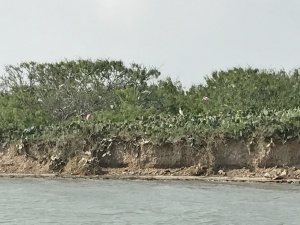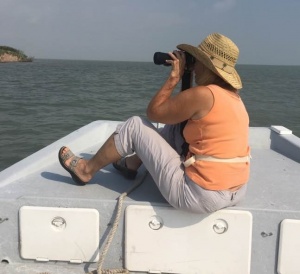When opportunity lands, I’m always happy to zip off for a new and awesome adventure.
Remember Stephanie Bilodeau? She spoke at our general meeting last year when she first hired on as the Coastal Bird Conservation Biologist in the Lower Laguna Madre.
And what an enviable job she has — weekly cruises on a boat in the peaceful Gulf under the Texas sun counting birds.

Along with her job comes a boat. While awaiting a new motor for it, her job still needed to be done.
Chapter member Frances Barrera and her husband, Joe, offered to boat her this week and my husband and I were invited along so the boys could talk while we counted birds.

And let me tell you! A morning spent drifting along in a boat with the draw and pull of a gentle tide near the spoil islands this time of year is an amazing and colorful sight!
Hundreds of birds — island hopping, carrying nesting materials, most already sitting nests while others stood guard perched on tree branches. Bright pink, purple, blue, black, white — amazing colors in the mesquite and prickly pear cactus vegetation of the islands.

We counted breeding colonial-nesting waterbirds on four islands north of the Arroyo Colorado River. Here’s the morning’s count:
Great Blue Heron: 128
Reddish egret (dark morph): 22
Reddish egret (white morph): 25
Roseate Spoonbill: 78
Neotropic Cormorant: 43
Tricolored Heron: 3
Snowy Egret: 2
Black-crowned Night Heron: 9
Such a sight! On the last island, 15 roseate spoonbills were sitting in one mesquite tree and about a dozen more in the dead mesquite at the island’s tip.
Heads of reddish egrets were showing throughout the prickly pear cactus beds, which is where they typically choose to nest, Stephanie said.


Roseate spoonbills are the easiest to see of course because of their vibrant colors. Slow sweeps looking through good binoculars brings into view the bright pink bills of reddish egret (dark morph). Striking colors against the green vegetation. “Amazing how many are hidden among the branches,” Frances noted.
Good binoculars are a must and “birding direction” language helps — like, “at two o’clock from the orange sign….”
Stephanie is a good instructor, patient, calm and has great vision. Sometimes the gentle rippling motion of the Gulf waters makes it hard to get a steady view from the bobbing boat. “Is that a night heron on the ridge, quarter of the way from the left” was enough for Stephanie to zoom to the correct spot. Yes! A total of nine black-crowned night herons ended up in the count.
While Frances and I, binoculars stuck to our faces, were oohing and awing at such a remarkable number of birds in one place, Stephanie remarked, “Not many people see this.” Indeed! And what a shame.

However, the opportunity is available for those who have a modicum of bird identification knowledge, good binoculars and half a day to do a purposeful volunteer job.
It’s an important job. “The majority of these waterbird species are in decline, so it is important to keep a close eye on the habits and size of our local breeding populations. This way we can determine the best way to manage their habitat to reverse their decline,” Stephanie said.
Stephanie manages and monitors 20-30 rookery islands in the Lower Laguna Madre from Port Mansfield down to Port Isabel. Many of these islands had never been managed for waterbirds before.
Well into her second year on the job, Stephanie has been working on many of the islands removing invasive plant species, planting native shrub species, and installing signs to keep people off the islands during the nesting season.
The management work stops in February to allow the birds a solitary and protective existence during breeding season. During breeding season, Stephanie closely monitors the number of adults, breeding pairs, nests and fledglings for each species on every island. This data can be compared year by year to detect changes in the populations.
In addition to recording information on the spoil islands activity a couple of times a week, Stephanie leads Boca Chica Beach migratory waterbird surveys when she can.
South Padre Island needs the same counts. But only if more volunteers come forward because Stephanie is not able to be present for most of these surveys. “That’s why volunteer involvement is important,” Stephanie said.
If you saw Frances’ Facebook posting last week, she had joined the recent Boca Chica Beach count. “Easy hours, fun in the sun, sparkling water and personalities,” she posted.

Counting birds is an easy way to chock up volunteer hours and easy on the muscles! Non-taxing, stress-free, you won’t even work up a sweat!
From Monday’s observations, the tricolored herons and snowy egrets were still building nests, others were sitting on eggs and some may have had chicks in the nests. Stephanie saw one fledged white morph reddish egret whose parents must have gotten a head start!
The migratory waterbird surveys will conclude at the end of May and the island monitoring concludes around September when all the young birds have fledged.
Anyone interested in helping this vital count at Boca Chica or South Padre Island, or wanting to join a boat trip with Stephanie, please get in touch with her.
Stephanie Bilodeau can be reached a number of ways. You can sign up for migratory waterbird survey shifts at Boca Chica by going to her Doodle poll link: http://doodle.com/poll/cvwxyzh5gpw3qz2k and selecting the shifts you are available for.
Cell: 802-309-5171
E-mail: stephanie@cbbep.org
Check out the Website www.cbbep.org and Facebook page www.facebook.com/CBBEPCoastalBirds
Coastal Bird Conservation Biologist Stephanie Bilodeau – Coastal Bird Program, Coastal Bend Bays & Estuaries Program, Lower Laguna Madre Region.
